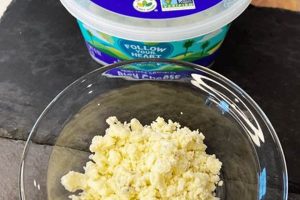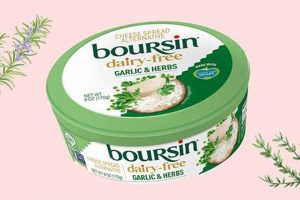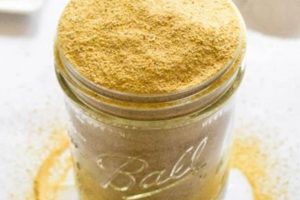A plant-based alternative to traditional dairy brie, this product seeks to replicate the creamy texture and distinct flavor profile of its counterpart using non-animal ingredients. Common formulations incorporate nuts (such as cashews or almonds), plant-based oils, and cultures to achieve the desired consistency and taste through fermentation processes. This cheese analog presents a viable option for individuals adhering to vegan diets or those with dairy sensitivities.
The increasing demand for dairy-free alternatives is fueling the development and availability of such products. These offerings cater to ethical, environmental, and health concerns associated with conventional dairy production. The historical context involves a broader movement toward plant-based eating and the technological advancements in food science that enable the creation of convincing dairy substitutes.
Further exploration of the ingredients, production methods, nutritional aspects, and market trends surrounding this type of cheese alternative is warranted to provide a more comprehensive understanding. Subsequent sections will delve into these specific areas, providing a detailed analysis of its composition, manufacturing process, and place in the evolving landscape of plant-based foods.
Tips for Working with Vegan Brie Alternatives
Achieving optimal results when utilizing plant-based brie substitutes requires consideration of specific handling and preparation techniques. The following recommendations aim to assist in maximizing the flavor and texture potential of these products.
Tip 1: Temper Before Serving. Allowing the vegan brie to reach room temperature (approximately 20-30 minutes) prior to consumption enhances its creamy texture and intensifies its flavor profile. This step is crucial for achieving a sensory experience comparable to traditional dairy brie.
Tip 2: Utilize Complementary Flavors. Pair the vegan brie with ingredients that accentuate its natural characteristics. Fruits like apples, pears, or grapes, as well as nuts such as walnuts or pecans, provide contrasting textures and flavors that elevate the overall tasting experience.
Tip 3: Exercise Caution When Baking. While some vegan brie alternatives are designed for baking, it is essential to monitor the product closely to prevent melting or separation. Preheating the oven to a moderate temperature and using a baking sheet lined with parchment paper is recommended.
Tip 4: Consider the Base Ingredients. Different formulations (e.g., cashew-based, almond-based, coconut-based) will yield varying textures and flavors. Understanding the primary ingredients allows for informed pairing and usage decisions.
Tip 5: Prioritize Quality Over Price. Investing in higher-quality plant-based brie alternatives often results in a more authentic taste and texture. Examining the ingredient list and opting for products with minimal additives is advisable.
Tip 6: Explore Cultured Options. Vegan brie products that incorporate live cultures offer a more complex flavor profile and a texture that more closely mimics traditional brie. These options are often fermented, resulting in a tangier and more nuanced taste.
These guidelines emphasize the importance of understanding the nuances of vegan brie alternatives to ensure a satisfying culinary experience. Thoughtful preparation and strategic pairing contribute significantly to unlocking the full potential of these plant-based products.
The following sections will delve into the nutritional information and comparative analysis of various vegan brie brands, providing a comprehensive overview of the market landscape and consumer considerations.
1. Ingredients
The selection of ingredients is paramount in the creation of convincing vegan cheese brie. These components directly influence the product’s texture, flavor, and overall resemblance to its dairy-based counterpart. Cashews, for example, are frequently employed as a base due to their high fat content and creamy consistency when processed. Other common ingredients include almonds, macadamia nuts, coconut oil, and various plant-based starches. The specific combination and proportions of these elements determine the final product’s characteristics. Using refined coconut oil, as opposed to unrefined, results in a more neutral flavor profile, mitigating the distinct coconut taste. The addition of tapioca starch or potato starch can contribute to a softer, more pliable texture that mimics the melt of traditional brie. Without careful ingredient selection and blending, achieving the desired sensory qualities is not possible.
Beyond the primary ingredients, other components play critical roles in achieving the desired flavor and texture. Nutritional yeast contributes a savory, umami note often associated with cheese. Lactic acid or other vegan-friendly acids introduce a subtle tanginess, mimicking the fermentation process in dairy brie. Stabilizers, such as agar-agar or carrageenan, are used to bind the ingredients and prevent separation, ensuring a smooth and consistent product. Consider the example of a cashew-based brie lacking sufficient stabilizers: it may exhibit a grainy texture and oil separation, diminishing its appeal. Conversely, excessive use of stabilizers can result in a rubbery or unnatural consistency.
In summary, the success of vegan cheese brie hinges on the judicious selection and utilization of its ingredients. Careful consideration must be given to the base ingredients’ fat content and flavor profiles, as well as the roles of acids, nutritional yeasts, and stabilizers. The practical significance of this understanding lies in the ability to produce a palatable and texturally appealing alternative for consumers seeking dairy-free options. Challenges remain in replicating the full complexity of dairy brie, but ongoing advancements in ingredient technology and processing techniques hold promise for further refinement and improvement.
2. Fermentation
Fermentation is a crucial process in the creation of vegan cheese brie, contributing significantly to its flavor, texture, and preservation. While traditional cheese relies on animal-derived cultures, the production of plant-based brie necessitates the use of vegan-friendly alternatives to achieve similar results.
- Culture Selection
The choice of microbial cultures is paramount. Specific strains of bacteria, such as Geotrichum candidum and Penicillium candidum, are often employed to replicate the rind formation and characteristic flavors of traditional brie. These cultures metabolize compounds in the base ingredients, leading to the development of aromatic and textural complexities. For example, Geotrichum candidum aids in the breakdown of proteins and fats, contributing to the creamy mouthfeel and bloomy rind. The selection of inappropriate cultures can result in off-flavors or undesirable textures.
- Substrate Interaction
The fermentation process depends on the interaction between the selected cultures and the plant-based substrate. Different base ingredients, such as cashews, almonds, or soy, provide varying nutrients for the cultures to metabolize. The presence of specific carbohydrates, proteins, and fats influences the rate and type of fermentation. A cashew-based brie, for instance, might ferment differently than one made from coconut, affecting the final flavor profile. Adjustments to the substrate composition are often necessary to optimize the fermentation process and achieve the desired characteristics.
- pH Regulation
Maintaining an optimal pH level is essential for successful fermentation. The activity of microbial cultures is highly sensitive to pH, and deviations can inhibit their growth or lead to the production of unwanted byproducts. Lactic acid bacteria, commonly used in vegan cheese production, produce lactic acid, which lowers the pH and contributes to the characteristic tanginess of brie. Monitoring and adjusting the pH during fermentation ensures that the cultures remain active and produce the desired flavor compounds. For instance, adding calcium carbonate can help regulate pH during fermentation.
- Ripening Process
Following fermentation, a ripening period is crucial for the development of the final flavor and texture. During ripening, enzymes produced by the cultures continue to break down proteins and fats, leading to the formation of complex flavor compounds. The duration and conditions of ripening, such as temperature and humidity, significantly impact the final product. A prolonged ripening period can result in a more intense flavor and a softer texture, while insufficient ripening may yield a bland and firm product. Controlling these factors is vital for achieving the desired sensory qualities.
The fermentation process is integral to producing vegan cheese brie that closely mimics the attributes of its dairy-based counterpart. By carefully selecting cultures, managing the substrate interaction, regulating pH, and controlling the ripening process, manufacturers can create plant-based brie alternatives with complex flavors and textures. Continuing research and development in fermentation techniques will likely lead to further improvements in the quality and variety of vegan cheese brie available to consumers.
3. Texture
Texture is a paramount sensory attribute governing consumer acceptance of vegan cheese brie. Replicating the smooth, creamy, and often yielding texture of traditional brie is a significant challenge in plant-based alternatives. The success of a vegan cheese brie product hinges on its ability to mimic the textural experience of its dairy counterpart.
- Base Ingredient Impact
The primary ingredients, such as cashews, almonds, or coconut oil, fundamentally dictate the final texture. Cashews, when properly processed, contribute a creamy, almost buttery mouthfeel. Almonds, if not finely ground, can result in a grainier texture. Coconut oil, while providing a smooth consistency at refrigerated temperatures, may become overly soft or oily at room temperature. Ingredient selection therefore necessitates careful consideration of the desired textural outcome and the individual properties of each component.
- Processing Techniques
Methods such as fermentation, blending, and aging significantly influence the texture. Fermentation, employing specific cultures, breaks down proteins and fats, resulting in a softer, more pliable product. Inadequate blending can leave pockets of unmixed ingredients, leading to an uneven texture. Controlled aging allows enzymes to further modify the structure, impacting firmness and spreadability. Each step requires precise execution to achieve the target texture.
- Stabilizers and Emulsifiers
The use of stabilizers and emulsifiers is often essential to maintain a consistent texture. Ingredients like agar-agar, tapioca starch, or plant-based gums prevent separation of water and fat, ensuring a smooth and homogenous product. However, excessive use of these additives can lead to a rubbery or artificial texture, detracting from the overall sensory experience. The optimal balance necessitates careful calibration of stabilizer concentration.
- Moisture Content
Moisture content is a critical determinant of texture. A higher moisture content generally contributes to a softer, creamier texture, while a lower moisture content results in a firmer, drier product. Controlling the moisture level during production is essential to achieve the desired consistency. For example, excessive moisture can lead to a product that is overly soft and prone to separation, while insufficient moisture can result in a dry and crumbly texture.
The interplay of ingredients, processing techniques, stabilizers, and moisture content ultimately defines the texture of vegan cheese brie. Achieving a texture that closely mimics traditional brie requires a nuanced understanding of these factors and their interactions. The development of innovative techniques and ingredient combinations remains a critical area of focus for manufacturers seeking to improve the sensory appeal of plant-based cheese alternatives.
4. Flavor
Flavor is a pivotal attribute of any food product, and its accurate replication is crucial for the acceptance of vegan cheese brie as a viable alternative to traditional dairy brie. Achieving a flavor profile that resonates with consumers accustomed to the complex nuances of dairy-based brie presents a significant challenge.
- Base Ingredient Contributions
The foundational ingredientssuch as cashews, almonds, or coconut oilinherently contribute base notes to the final flavor. Cashews often impart a slightly sweet and nutty flavor, while coconut oil may introduce a subtle tropical essence. These underlying flavors necessitate careful management to avoid overpowering the desired brie-like characteristics. For example, if coconut oil is used, a deodorized or refined version is frequently preferred to minimize its distinctive flavor impact.
- Role of Fermentation
Fermentation is critical in developing the complex flavors associated with brie. Specific cultures, such as Geotrichum candidum and Penicillium candidum, metabolize compounds within the base ingredients, yielding volatile aromatic compounds that contribute to the overall flavor profile. The precise cultures employed and the duration of fermentation significantly influence the final taste. A longer fermentation period may result in a more pungent, complex flavor, while a shorter period may yield a milder, less nuanced taste.
- Impact of Additives and Seasonings
Additives and seasonings are often used to enhance or mimic specific flavor characteristics. Nutritional yeast, for instance, contributes a savory, umami note that resembles the depth of flavor found in aged cheeses. Lactic acid or other vegan-friendly acids provide a subtle tanginess that mimics the natural acidity of dairy brie. White pepper, garlic powder, or onion powder can further enhance the overall flavor complexity. Overuse of such additives, however, can result in an artificial or unbalanced flavor profile.
- Aging and Flavor Development
The aging process allows for further flavor development through enzymatic activity and chemical reactions. During aging, proteins and fats are broken down into smaller molecules, releasing aromatic compounds that contribute to the overall flavor complexity. The temperature and humidity conditions during aging significantly influence the rate and type of flavor development. For example, aging vegan brie at slightly warmer temperatures may accelerate the development of more intense, pungent flavors.
In conclusion, the flavor of vegan cheese brie is a multifaceted attribute influenced by base ingredients, fermentation processes, the judicious use of additives, and the aging process. Achieving a palatable and authentic flavor profile requires a comprehensive understanding of these factors and their interactions. Continued research and development in ingredient selection, fermentation techniques, and aging strategies are essential for improving the flavor of plant-based brie alternatives and enhancing their appeal to a wider consumer base.
5. Applications
The scope of potential applications for vegan cheese brie is broad, extending across various culinary contexts and dietary preferences. Its versatility as a plant-based alternative contributes significantly to its market appeal and adoption by consumers seeking dairy-free options.
- Charcuterie Boards and Appetizers
Vegan cheese brie serves as a centerpiece on charcuterie boards, offering a creamy, spreadable element that complements fruits, nuts, crackers, and other savory items. Its presence allows for the creation of inclusive appetizer arrangements catering to diverse dietary needs. For instance, a board might feature vegan brie alongside grapes, figs, walnuts, and gluten-free crackers, accommodating both vegan and gluten-free guests.
- Baked Dishes and Gratins
Certain formulations of vegan cheese brie exhibit meltability suitable for use in baked dishes such as gratins, tarts, and pastries. While the melting characteristics may differ from traditional dairy brie, select varieties can provide a creamy, flavorful component to these culinary creations. A vegan brie and asparagus tart, for example, showcases the product’s ability to integrate into warm, savory preparations.
- Sandwiches and Wraps
The soft, spreadable texture of vegan cheese brie lends itself well to sandwiches and wraps, offering a dairy-free alternative to conventional cheese slices or spreads. Its flavor profile complements a variety of ingredients, from vegetables and grilled plant-based proteins to sweet and savory condiments. A simple sandwich featuring vegan brie, roasted vegetables, and balsamic glaze exemplifies this application.
- Sauces and Dips
Vegan cheese brie can be incorporated into sauces and dips, providing a creamy base and subtle cheesy flavor. Blending vegan brie with plant-based milk, herbs, and spices allows for the creation of rich, dairy-free sauces suitable for pasta dishes, vegetable toppings, or dipping sauces. A creamy vegan brie sauce with roasted garlic and herbs, served over pasta, illustrates this versatility.
The applications of vegan cheese brie reflect its adaptability within diverse culinary settings. Its ability to serve as a direct substitute in traditional recipes, as well as an innovative ingredient in new creations, underscores its significance in the evolving landscape of plant-based cuisine. Further refinement of its melting properties and flavor profiles will likely expand its applicability and appeal to a broader audience.
6. Availability
The availability of vegan cheese brie directly impacts its market penetration and consumer adoption. Limited distribution channels restrict access, hindering its ability to become a mainstream alternative to traditional dairy brie. Conversely, wider availability fosters increased consumer awareness and purchasing opportunities, driving sales and solidifying its position within the plant-based food sector. Supermarket chains and specialty food stores that stock vegan cheese brie provide greater visibility and accessibility, while its absence from these outlets limits exposure to potential customers. For example, if a major grocery retailer chooses not to carry vegan brie, a significant segment of the consumer base will remain unaware of its existence or unable to easily procure it. This underscores the critical relationship between distribution networks and product success.
Online retailers and e-commerce platforms also play a crucial role in expanding the accessibility of vegan cheese brie. These platforms overcome geographical limitations, allowing consumers in regions with limited physical retail options to purchase the product. Specialty vegan marketplaces and direct-to-consumer sales channels further enhance availability by catering specifically to the plant-based community. Consider, for example, a small-scale vegan cheese producer who primarily sells online; their reliance on e-commerce is essential for reaching customers beyond their local area. Moreover, the presence of vegan cheese brie on restaurant menus and in prepared food offerings significantly increases exposure and trial opportunities. When a restaurant incorporates vegan brie into a popular dish, it introduces the product to a wider audience and potentially encourages subsequent retail purchases.
Ultimately, the availability of vegan cheese brie is a determining factor in its growth and acceptance within the broader food market. Strategic distribution partnerships, expansion into mainstream retail channels, and active engagement with online platforms are essential for maximizing its reach and establishing it as a readily accessible option for consumers seeking plant-based alternatives. Challenges remain in overcoming limited shelf space and securing distribution agreements, but continued efforts to improve availability will be instrumental in driving the long-term success of vegan cheese brie. The product’s accessibility is intertwined with its perceived value and potential to disrupt the dairy-based cheese market.
Frequently Asked Questions
This section addresses common inquiries and misconceptions surrounding vegan cheese brie, providing clarity on its composition, production, and usage.
Question 1: What ingredients are typically used to produce vegan cheese brie?
Common ingredients include cashews, almonds, or other nuts as a base, supplemented by plant-based oils, thickeners (such as tapioca starch or agar-agar), nutritional yeast for flavor, and cultures for fermentation. Specific formulations vary among manufacturers.
Question 2: How does vegan cheese brie achieve a texture similar to dairy brie?
Achieving a brie-like texture involves careful ingredient selection and processing. Nuts are often soaked and blended to create a smooth base. Starches and gums contribute to the desired consistency. Fermentation also plays a role in softening and texturizing the final product.
Question 3: Does vegan cheese brie melt like traditional dairy brie?
Melting properties vary depending on the specific formulation. Some vegan cheese brie products are designed to melt, while others may soften or spread instead. It is essential to check the product packaging for specific melting instructions and expectations.
Question 4: What is the flavor profile of vegan cheese brie?
The flavor of vegan cheese brie aims to replicate the mild, creamy, and slightly tangy taste of dairy brie. Nutritional yeast contributes a savory, umami note, while fermentation processes introduce complexity and depth. Additives and seasonings further enhance the overall flavor profile.
Question 5: How does the nutritional content of vegan cheese brie compare to traditional dairy brie?
Nutritional content varies by brand and formulation. Generally, vegan cheese brie is cholesterol-free and lower in saturated fat than dairy brie. However, it may also differ in protein, calcium, and other micronutrient content. Reviewing the nutrition facts label is crucial for making informed dietary choices.
Question 6: Is vegan cheese brie suitable for individuals with nut allergies?
Many vegan cheese brie products contain nuts, particularly cashews. Individuals with nut allergies should carefully review the ingredient list and avoid products containing allergens. Nut-free formulations may exist, but thorough research is essential prior to consumption.
Understanding these fundamental aspects of vegan cheese brie aids in informed decision-making and promotes a more comprehensive appreciation of its characteristics.
The subsequent section will delve into the market trends and consumer preferences shaping the future of vegan cheese brie.
Conclusion
The preceding analysis provides a comprehensive overview of vegan cheese brie, encompassing its ingredients, production methods, textural and flavor characteristics, diverse applications, and market availability. The examination underscores the complexities involved in replicating the sensory attributes of traditional dairy brie using plant-based alternatives. The exploration further highlights the role of fermentation, stabilizers, and strategic ingredient selection in achieving a palatable and commercially viable product.
Continued innovation in food science and technology is essential for further refinement of vegan cheese brie. A deeper understanding of the underlying biochemical processes and consumer preferences will drive future development. This product category holds the potential to significantly impact the plant-based food market and contribute to a more sustainable and inclusive food system. It now falls to researchers, producers, and consumers to shape its trajectory.







